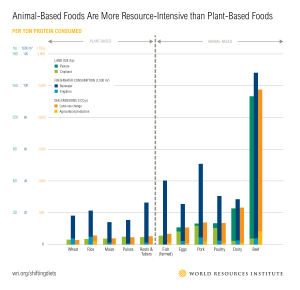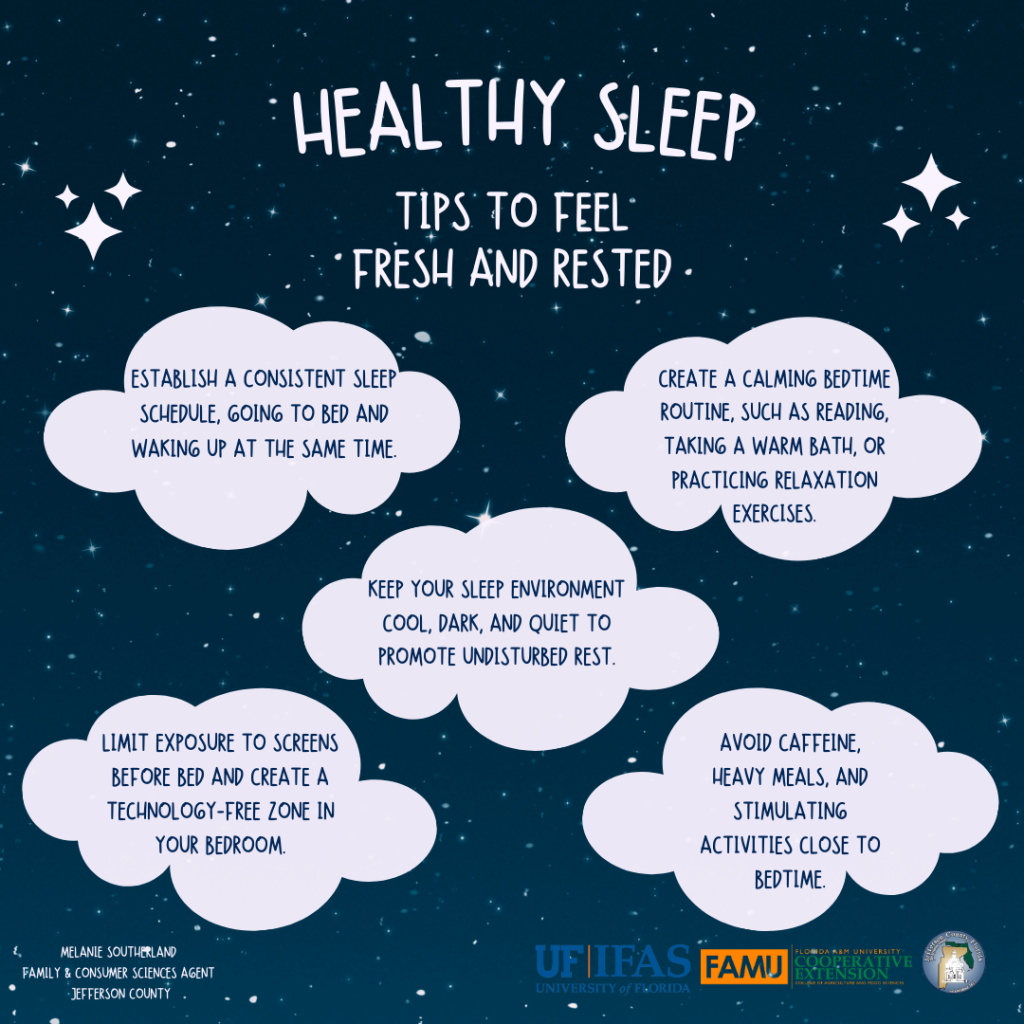
by Suzanne Holloway | Apr 28, 2025
Dietary protein is an important macronutrient for human health, and it can be found in a wide variety of foods. To learn more about the basics of protein, check out this earlier article.
Types of Protein Sources
Before we explore the different types of protein food sources, it is important to think about what else comes with it. When you eat foods that are rich in protein, you are also getting other things like fats, fiber, sodium, and other nutrients. Current evidence suggests that the “protein package,” has a greater impact on our health than the amount of protein eaten.
Traditional Animal-based

Source: World Resource Institute (Click on the image to see a larger version.)
Traditional sources like beef, pork, lamb, poultry, and seafood usually come from farms or wild sources. These proteins are complete protein sources because they contain all nine essential amino acids: histidine, isoleucine, leucine, lysine, methionine, phenylalanine, threonine, tryptophan, and valine. Additionally, animal-based protein is referred to as “high-quality” protein due to its high concentration of amino acids and digestibility, rather than its impact on human health or the environment. Regardless, it is important to note that not all animal-based proteins are created the same.
Red and Processed Meats
Red meats like beef, pork, and lamb, and processed meats, such as luncheon meats, hot dogs, and jerky, are high in saturated fats; furthermore, processed meats also contain a high amount of sodium. High intake of red meat, especially processed meats, has been linked to increased risk of cardiometabolic diseases, like heart disease, stroke and type 2 diabetes, and various cancers.
Dairy
Dairy products like milk, cheese, and yogurt are good sources of calcium, protein, and other important nutrients. But they can also have a lot of saturated fat, so it is better to consider the low-fat options.
Poultry and Eggs
Poultry, like chicken and turkey, is defined as a “high quality” and complete protein source like red meat. However, poultry, unlike red meat, generally has a lower saturated fat content; a notable exception to this generalization is duck. Eggs are also a complete source of protein with healthy fats and other nutrients.
Seafood
Seafood, such as salmon, Pacific oysters, tuna, and whitefish contain important types of omega-3 fatty acids, like eicosapentaenoic acid (EPA) and docosahexaenoic acid (DHA). Omega-3 fatty acids are a type of polyunsaturated or “healthy” fat; they play an important role in cellular membrane function and support the function of the cardiovascular and endocrine systems. The major concern involved in consuming seafood, specifically fish, is the amount of mercury present; however, these levels vary between species. For advice on eating fish, check out this article from the FDA.
Plant-based
Beans, Peas, Lentils, Grains, and Soy
Beans, peas, and lentils are great plant-based proteins that also give you fiber, vitamins, and minerals. However, typically, a single type of bean, pea, or lentil does not constitute a complete protein by itself. It is advised to mix different types or add other foods to get complete protein, like the classic combination of rice and beans. Soybeans and soy products, like tofu and tempeh, are also a good source of protein, especially for those on a vegan and vegetarian diet. Rice is also a good source of protein, but like other plant-based sources, does not provide a complete protein and should be combined with other foods to ensure adequate intake.
Nuts and Seeds
Nuts and seeds like almonds, peanuts, chai seeds, and sunflower seeds, are a good source of protein and healthy fats. However, due to their high fat and calorie content be mindful of your portion sizes. Quinoa, which is often classified as a pseudo-cereal but is a seed, is a complete protein.
Microbe-based
Microbial protein comes from microorganisms, mainly fungi (such as yeasts and filamentous fungi), microalgae (like cyanobacteria), and bacteria. The utilization of microbes for protein and food processing is not a new idea and can be observed in the making of bread, yogurt, and cheese, as well as in the direct consumption of yeast and algae. Two of the most well-known types of microbe-based proteins are nutritional yeast and spirulina. Some of the limitations of microbe-based proteins are the cost and product quality. They are not considered a complete protein because microbial protein only has eight out of the nine essential amino acids.
Insect-based
The practice of consuming insects, such as grasshoppers, ants, bees, and caterpillars, has long been established in several cultures throughout South and Central America, Africa, Asia, Oceania, and Europe. Insect-based protein is similar in quality to that from livestock but is more resource-efficient. However, it is important to consider species-specific health concerns, such as potential microbial, allergenic, and toxicological risks.
Cultivated Animal-based
Cultivated or lab-grown meat is an innovative technology that could transform the traditional meat industry. This process involves extracting cells from an animal, without slaughter, and then the cells are grown, harvested, and processed into meat for human consumption. The first lab-grown meat, a beef burger patty that cost $330,000, was developed by a scientist in the Netherlands in 2013. Since then, technological advancements have expanded product offerings to include cell-cultivated versions of pork, chicken, and seafood. The significant challenges facing the cultivated meat industry include scaling up production, reducing the costs of finished products, and replicating the taste and texture of conventional animal products. Still, since it comes from animal cells, it is a complete protein source.
Conclusion
Each protein source comes with its unique set of nutrients, which collectively impact our health more than the protein content alone. Understanding the complexities of each protein source—from traditional animal-based proteins to innovative lab-grown meats—helps us make informed dietary choices that align with our needs and considerations.
Additional Sources
Harvard Health
American Heart Association
World Resources Institute
The Nutrition Source
An Equal Opportunity Institution.

by Samantha Kennedy | Feb 27, 2025

National Nutrition Month helps promote healthy eating for individuals and families. (Photo source: Academy of Nutrition and Dietetics, eatright.org)
Maintaining a healthy diet is more crucial than ever. According to the Academy of Nutrition and Dietetics, a nutritious, balanced eating plan is essential for optimal health at every stage of life. Healthy eating not only helps manage weight and prevent chronic diseases but also boosts mental well-being and energy levels.
Healthy eating involves consuming a variety of foods that provide the nutrients needed to maintain health, feel good, and have energy. These nutrients include protein, carbohydrates, fat, water, vitamins, and minerals. A balanced diet includes fruits, vegetables, whole grains, and lean proteins, which are vital for maintaining a healthy body and mind.
The benefits of healthy eating are numerous. It can reduce the risk of chronic diseases such as heart disease, diabetes, and cancer. Additionally, a nutritious diet supports brain function, improves mood, and enhances overall quality of life. For instance, incorporating more fruits and vegetables into your diet can provide essential vitamins and minerals that boost your immune system and keep you feeling energized.
Beyond its nutritional value, food has a unique ability to bring people together. The theme for National Nutrition Month 2025, “Food Connects Us,” highlights how food plays a significant role in our social lives.
Sharing meals is a universal experience that transcends cultural and geographical boundaries. It fosters a sense of community and belonging, whether it is a family dinner, a holiday feast, or a casual get-together with friends.
Food connects us to our heritage and traditions. Many cultures have specific dishes that are passed down through generations, each with its own story and significance. These culinary traditions are often at the heart of celebrations and rituals, reinforcing cultural identity and continuity.
Moreover, preparing and sharing meals can strengthen relationships. Cooking together can be a fun and educational activity that encourages teamwork and communication. It provides an opportunity to learn about different ingredients, cooking techniques, and cultural practices. Eating together allows for meaningful conversations and the sharing of experiences, which can deepen bonds and create lasting memories.
Promoting both healthy eating and the social aspects of food can be achieved through various initiatives. National Nutrition Month encourages people to make informed food choices and develop sound eating and physical activity habits.
Communities can organize events such as cooking classes, nutrition workshops, and communal meals to educate and engage people in healthy eating practices. Schools and workplaces can also play a role by providing nutritious meal options and creating environments that support healthy lifestyles. Encouraging family meals at home can help children develop healthy eating habits and strengthen family connections.
Healthy eating is vital for maintaining physical and mental well-being. At the same time, food has the power to bring people together, fostering a sense of community and connection. By embracing both the nutritional and social aspects of food, we can enhance our health and enrich our lives.
An Equal Opportunity Institution

by Suzanne Holloway | Feb 27, 2025
Defining Proteins
Proteins are important macronutrients, just like carbohydrates and fats. They are large, complex molecules that play numerous roles in the body. For instance, proteins help in building and repairing structures, performing bodily functions, and regulating various processes within the body. You can find proteins essentially everywhere in the body from bones, muscles, enzymes, hormones, skin, and blood.
About Amino Acids
Proteins are composed of smaller parts called amino acids. These amino acids join together to form long, folded chains known as polypeptides. There are 20 different types of amino acids, each with unique properties. Our bodies cannot produce nine specific amino acids, so we need to get them from our food. There are conditionally essential amino acids, which are necessary only during times of sickness and stress. Furthermore, the body can make nonessential amino acids even if they are not present in the foods we eat. Here’s a quick look at these amino acids:
| Name |
Classification |
| Alanine |
Nonessential |
| Arginine |
Conditionally Essential |
| Asparagine |
Nonessential |
| Aspartic acid |
Nonessential |
| Cysteine |
Nonessential |
| Glutamic acid |
Nonessential |
| Glutamine |
Conditionally Essential |
| Glycine |
Conditionally Essential |
| Histidine |
Essential |
| Isoleucine |
Essential |
| Leucine |
Essential |
| Lysine |
Essential |
| Methionine |
Essential |
| Phenylalanine |
Essential |
| Proline |
Conditionally Essential |
| Serine |
Conditionally Essential |
| Threonine |
Essential |
| Tryptophan |
Essential |
| Tyrosine |
Conditionally Essential |
| Valine |
Essential |

Meat, poultry, fish, dairy, beans, and legumes are all good sources of protein. (Adobe Stock photo)
Recommendations
But how much protein do you need? This varies based on several factors such as weight, height, age, sex, and activity level. Generally, 10% to 35% of your daily calories should come from protein. In terms of weight, it’s recommended that a person consumes about 0.36 grams of protein per pound of body weight. It is important to know that one gram of protein provides four calories.
For a 2,000-calorie diet, the daily intake of protein could range from 200 to 700 calories.
For a 200-pound person, the daily intake of protein could be 72 grams.
To determine your recommended protein intake, use one of the following methods:
- Multiply your daily caloric intake by 0.10 – 0.35.
- Multiply your weight by 0.36.
- Use this Dietary Reference Intakes (DRI) Calculator.
However, if you are pregnant, protein intake should increase. Talk with your doctor about specific protein needs.
When considering your protein source, it is important to consider how it is packaged. You are not just eating the protein found in foods, but the fats, carbohydrates, vitamins, minerals, and other nutrients accompanying it. Ideally, you should choose protein sources that are low in saturated and trans fats and processed carbohydrates. We will discuss the pros and cons of the different protein sources in an upcoming post.
An Equal Opportunities Institution.
by Melanie Southerland | Dec 6, 2024
Did you know that 35% of adults in the U.S. do not get the recommended 7 or more hours of sleep each night [1]? Sleep deprivation is on the rise and can negatively affect overall health. The body’s ability to function properly and to feel rested is dependent upon how much sleep a person gets. Research shows that not getting the recommended amount of sleep each night correlates with obesity, along with other chronic conditions such as heart disease, diabetes, and high blood pressure [2].
Why is this important? Obesity is one of the leading causes of chronic disease and mortality in the U.S. People who are obese are more likely to have chronic diseases and die at an earlier age compared to non-obese individuals. Some things cannot be controlled regarding overall health but there are certainly ways to reduce the risk for chronic conditions and obesity. Aim for at least 150 minutes of moderate-intensity activity per week, sleep 7-9 hours each night, and eat various fruits and vegetables, lean protein, whole grains, and low-fat dairy to support health. There are various health benefits to getting enough sleep; for example, getting sick less often, staying at a healthy weight, reducing stress, and improving mood, improving attention and memory, and improving heart health and metabolism.
Sleep quality is important in addition to getting the recommended amount of sleep, you also need to ensure you are getting quality sleep. Quality sleep includes waking up feeling refreshed and rested, falling asleep easily and quickly, and staying asleep. If you wake often, have trouble falling asleep, and wake tired, you likely are not getting quality sleep. Here are some important sleep tips that could help you improve sleep and sleep quality. It is important to wake up and go to bed at the same time each day because that sets an expectation for your body’s internal clock to shut down and wake up. A nightly routine is important because it puts your body into a system that is preparing for sleep and staying consistent can help your body to understand that it is bedtime, and rest is around the corner. Limit screen time before bed because it is stimulating to the brain, which can make it harder to get to sleep, not to mention the added stress it could cause. Consider, reading a book, listening to soft music, and journaling as part of your relaxing nightly routine. Exercise can help reduce stress so, engaging in exercise is important not just for physical health, but for sleep health too.

[1]Center for Disease Control and Prevention. Sleep and Sleep Disorders. Data and statistics: Adults. https://www.cdc.gov/sleep/data-and-statistics/adults.html
[2] Watson NF, Badr MS, Belenky, G, et al. Recommended amount of sleep for a healthy adult: a joint consensus statement of the American Academy of Sleep Medicine and Sleep Research Society. Sleep. 2015; 38(6):843-844. Doi: 10.5665/sleep.4716
American Academy of Sleep Medicine. Sleep Education. Healthy sleep habits. https://sleepeducation.org/healthy-sleep/healthy-sleep-habits/

by Amy Mullins, PhD, RDN | Jun 24, 2024
 Your health Is directly related to how well your body responds to fight bacteria and viruses that can lead to inflammation, infection, and illness. This line of defense against intruders is known as the immune system. You can support your immune system and keep it strong with regular handwashing, proper nutrition, physical health, and mental well-being.
Your health Is directly related to how well your body responds to fight bacteria and viruses that can lead to inflammation, infection, and illness. This line of defense against intruders is known as the immune system. You can support your immune system and keep it strong with regular handwashing, proper nutrition, physical health, and mental well-being.
A healthy lifestyle, including a diet rich in nutritious foods, is important to your well-being and ability to maintain your immune system. Nutrient deficiencies can impair immune function and decrease the body’s resistance to infections. Nutrients work together to build a healthy immune system to defend against sickness.
Nutrition Strategies to Boost Your Immune System
- Don’t over-consume calories, saturated fats, or excess sugar and salt.
- Eat a well-balanced diet that includes a variety of fruits, vegetables, grains, and legumes.
- Read nutrition labels.
- Consider taking a daily multivitamin.
All nutrients are important, but several are particularly important to supporting your immune health, including antioxidants, Vitamin C, Vitamin A, Vitamin E, Vitamin D, zinc, and omega-3 fatty acids.
Phytonutrients and Antioxidants
Phytochemicals are naturally occurring compounds in plants that protect plants from fungus, germs, and insects and are responsible for the color, taste, and smell of plant foods.
In the body, many phytochemicals, vitamins, and minerals act as antioxidants, which help to protect cells from damage. Phytochemicals have health properties that are:
- Cardio-protective
- Anti-diabetic
- Anti-inflammatory
- Anti-cancer
Vitamin C strengthens the immune system, repairs damaged cells, and helps defend against foreign invaders. Vitamin C is found in a wide variety of fruits and vegetables such as oranges, grapefruit, and bell peppers.
Vitamin A is known to promote healthy growth and distribution of cells, and support skin and eye health. Sources include orange vegetables (pumpkin, carrots, and sweet potatoes), leafy greens (spinach, kale, and broccoli), fish, dairy products, and eggs.
Vitamin E has antioxidant properties that protect cells from damage, support a healthy heart, and may help to prevent some types of cancer. Good sources of Vitamin E include many plant oils like sunflower oil and almond oil and healthy fats found in avocado and almonds.
Vitamin D is known to promote anti-inflammatory cells and help regulate cells involved in the immune response and healing. Vitamin D is also needed for the body to absorb calcium. Sources include sunlight (your body makes vitamin D from sunlight!), fortified foods (usually dairy and soy products), and fatty fish (salmon, tuna, and mackerel).
Zinc is a trace element shown to improve brain function and strengthen the immune system by promoting wound healing and decreasing inflammation. Zinc is found in lean meats, seafood, legumes, and nuts.
Omega-3 fatty acids are important in controlling inflammation. The body cannot make these fatty acids so they must be consumed in the diet. Plant sources include chia seeds, edamame, avocado, and oats, while animal sources include salmon and tuna.
What About Supplements?
If a well-balanced diet Is not regularly accessible, you may consider taking a multivitamin. Talk with your healthcare provider to decide if a daily multivitamin or other dietary supplements are right for you. Always be sure to read labels carefully for the serving size, ingredients, and “USP Verified” seal to ensure the supplement contains the actual ingredients listed and is made according to FDA guidelines. Choose a multivitamin that is all-inclusive to meet the daily RDA (Recommended Dietary Allowance). Adhere to the serving size to meet the RDA for daily multivitamins or individual vitamin supplements, unless instructed otherwise by a doctor. Dangers of supplement interactions or overdose include upset stomach, headache, and blocking other nutrients from being absorbed by the body. For more information about dietary supplements, visit the U.S. Food & Drug Administration or the National Institutes of Health – Office of Dietary Supplements.
Additional Resources:
Centers for Disease Control and Prevention
https://www.cdc.gov/nccdphp/dnpao/features/enhance-immunity/index.html
Academy of Nutrition and Dietetics
https://www.eatright.org/health/wellness/healthful-habits/how-to-keep-your-immune-system-healthy
An Equal Opportunity Institution.








